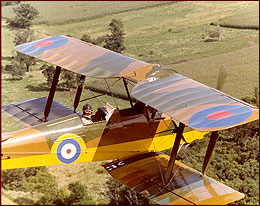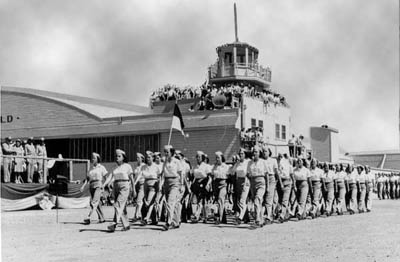
Criteria
for the Spirit of Flight Award
- Awarded
annually to an organization that has made a substantial
contribution to aviation in Illinois.
- The
organization's activities must be Illinois based and
continuous over a long period of time.
- The
organization's member activities must be above
and beyond that of normal paid employment and exhibit
a high degree of excellence in their accomplishment.
Significance
of the Spirit of Flight Award
Election to the Illinois Aviation Hall Of Fame is the highest honor
that can be attained by people whose principal aviation activity and
experience is Illinois based. It is awarded to people of good character
for their excellence over a period of time. All of those selected have
participated in community service, which reflects the character that
earns IAHOF honors.
2010
Recipient:
THE WASP OF ILLINOIS
 Early on in World War II the Army Air Force had a critical shortage of pilots. WASP made a great contribution to the war effort and to the future of military aviation yet, they were never officially recognized as part of our military air force. They were the Women's Air Force Service Pilots (WASP) and they freed hundreds of male pilots for combat duty. Many of these courageous women were from Illinois. Early on in World War II the Army Air Force had a critical shortage of pilots. WASP made a great contribution to the war effort and to the future of military aviation yet, they were never officially recognized as part of our military air force. They were the Women's Air Force Service Pilots (WASP) and they freed hundreds of male pilots for combat duty. Many of these courageous women were from Illinois.
There were actually two flying groups that eventually merged into the WASP organization. One was the Women’s Auxiliary Ferrying Squadron headed by Nancy Love. Applicants were required to have 500 hours flying time and a 200 horsepower rating. The second group was the Women's Flying Training Detachment created by Jacqueline Cochran and based at Avenger Field in Texas. Both groups merged and became the WASP organization in August of 1943. Over time their training programs went through many changes and eventually became a duplication of the Aviation Cadet program.
WASP pilots were restricted to daylight flights and primary trainers, but eventually things changed and they were able to fly all the first line fighters, bombers and transports in the Army Air Force inventory. By 1944, half in the ferrying Divisions were WASP pilots. They made most of the fighter deliveries in the States with a lower accident rate than male pilots.
Many became test pilots, while others were assigned to Training Command as flying cadet navigators, bombardiers and instrument instructors. In December of 1944, as the need for combat pilots declined, the WASP were deactivated. During their 26 month life, they drew 25,000 applicants; 1830 were accepted, 1074 won their wings and 38 lost their lives, while taking part in many different domestic flying activities.
These brave women ferried more than 12,000 aircraft of 76 different types. They also served without military benefits and were paid two thirds as much as the male civilian ferry pilots they had replaced. Some suffered much discrimination yet many offered to continue for a dollar a year. In 1947 the new independent Air Force offered commissions to former WASP.
The 122 who accepted were assigned to administrative and support duties and did not fly military aircraft again. Thanks to Barry Goldwater in 1977, Congress passed a bill that gave the WASP organization honorable discharges and declared them veterans.
At a ceremony this spring some 200 Wasps will receive the Congressional Gold Medal of Honor for service during World War II.
Unfortunately there are only approximately 200 WASP members still living, nationwide. Illinois is home to a few of these patriotic women. We do not have an accurate count as of today. The average age is over 87. We honor these exceptional women from Illinois with the Spirit of Flight Award on behalf of the entire WASP organization that gave so much in the defense of our great nation.
|
